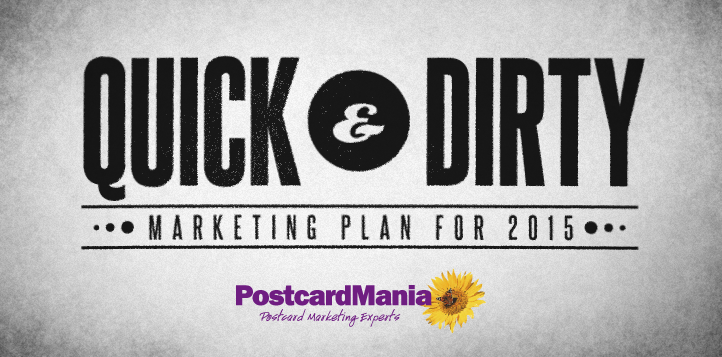
Simple strategies to create marketing plan tactics that deliver a consistent return on investment
There is a secret to “marketing plans” that most people fail to discover in their business lifetime. Are you ready for it? Hold on to your hat…
Marketing plans don’t have to be complicated.
GASP! Say it ain’t so (exclaim the peddlers of complicated marketing systems)!
Okay, everybody calm down. Note the wording there. They don’t HAVE to be complicated. That’s the key. They certainly CAN be complicated, and as a marketer becomes more advanced they usually DO get more complicated. And that’s fine, but not the point of this article.
For each type of small business, you can usually find one marketing tactic that produces a consistent and quality return on investment (ROI) – enough so that that marketing tactic alone would allow you to steadily grow your revenue. Think of this tactic as your marketing foundation. It is consistent, solid, and essentially removes the fear of your business (metaphorically) collapsing.
(After writing this, I immediately feel like there are those of you reading it who are saying to yourselves, “I haven’t found one yet for my business,” and this is the subject of another article that will probably just annoy you, but should read anyway. Because there really are tactics that will steadily increase your growth rate whether you believe it yet or not.)
Of course, you can add to that foundation, architecting a marketing structure so complicated and stunning we peasants must shield our eyes to look upon it. That’s your prerogative. But you don’t have to. See what I’m saying?
Now. To identify the quick and dirty marketing plan that’s right for your business, you have to figure out which “lifetime value” category you fall into:
A. The lifetime value of my average customer is MORE than $500. (Most businesses fall under this category.)
In other words, either your product/service costs more than $500, OR your average customer buys from you more than once with the total purchases adding up to more than $500. For example, maybe the average sale for a barber is $30. That’s not $500 obviously. However, that barber’s average customer stays with him for 5 years and gets a haircut quarterly. That’s $120 per year for 5 years, which comes to $600 for the lifetime value of the customer. The barber would qualify under this category.
B. The lifetime value of my average customer is LESS than $500.
In other words, your product/service costs less than $500, AND you only sell once to your average customer. A good example of this is an author. Maybe your book costs $30, but your customer is only going to buy once in his lifetime (unless he gets another as a gift or something, but that’s not bankable and you’d still fall short of $500). An author would fall under this category.
NOTE: I painstakingly identified the $500 benchmark number over the course of 16 years and direct mail experience with over 65,000 small businesses. It is not pulled from a hat. It is – as is said – “too legit to quit.”
So, do you know if you’re an A or a B? Here is your quick and dirty marketing plan for 2015:
If you’re an A – Direct Mail Postcards
Specifically, direct mail will work for you (and more specifically, DirectMail2.0 – a new option offered by the more progressive direct mail companies). I know direct mail isn’t the sexy answer (although DirectMail2.0 is considerably sexier, as it comes with automatic online follow-up through Google and call tracking that makes tracking your results exact and simple), but foundations aren’t sexy. They’re there to keep you safe, alive and stress-free. Which I guess is a little sexy actually… And that was before DirectMail2.0, which has – and I’m not exaggerating – totally changed the way I do business (for the better).
If you’re a B – Google Pay Per Click (PPC – another name for it is Google AdWords)
If you’re a B, direct mail postcards won’t generate the ROI you need to be successful. I have seen too many people in this category try postcards because of the results they see “A” businesses getting. But it just isn’t feasible for you. Instead, you want to load up on Google Pay Per Click (and other online PPC, like Facebook ads). This gives you the ability to target huge amounts of potential buyers, and only spend your budget if they actually click on the ad.
If you aren’t familiar with PPC platforms, I highly recommend you retain a trustworthy company to handle your campaigns for you. I’ve seen too many business owners try this on their own, lose money and make the blanket decision to “never do that again.” You can do it yourself, but be prepared to spend a LOT of time upfront learning the systems. If you don’t, it won’t work and you won’t like the results. But when handled properly, PPC will form that stable foundation for your marketing.
The key to making both of these plans work is also easy: CONSISTENCY.
Once you have your plan, stick to it! Don’t dip your toe in the water, decide you don’t like it and run for the hills. After growing my own business from just a one-person startup with only a phone and computer into a $22 million industry leader (it isn’t bragging if it’s true, right?), I’ve toyed with cutting back on marketing a few times in our 16-year history, and you know what? It always bites into my bottom line. It isn’t worth it. I want my company to grow and prosper year after year, and cutting my marketing budget is the fastest way to sabotage that growth.
Okay, enough with the lessons! Now comes the part where you start putting your quick and dirty marketing plan in place for 2015 so you can kick off the New Year in style! Good luck, and don’t hesitate to contact me for advice or pointers! You can reach me via email at Joy.Gendusa@PostcardMania.com. Happy Holidays!



